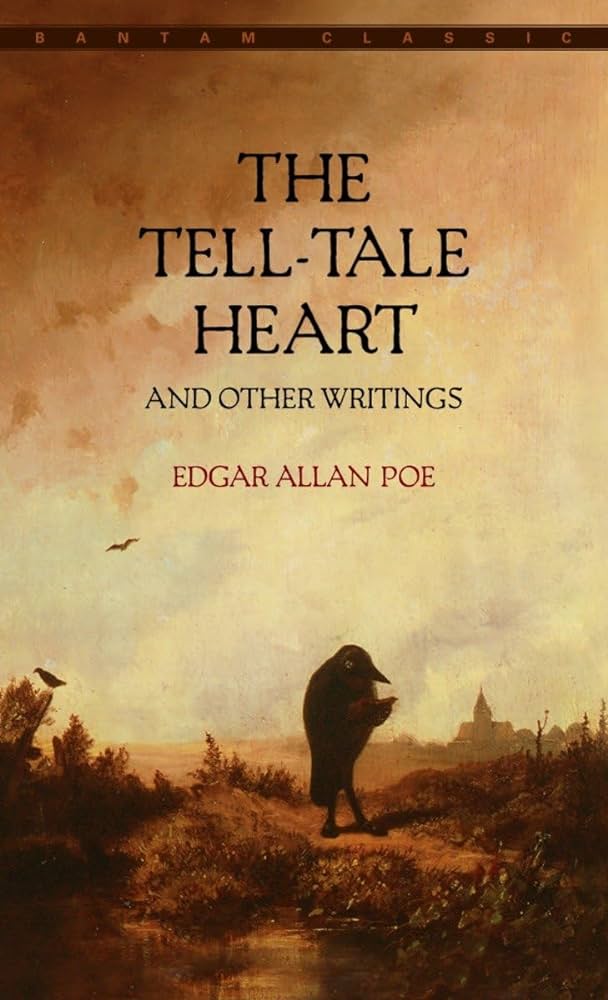The Tell-Tale Heart stands as a chilling short story penned by the renowned American writer Edgar Allan Poe, marking its first publication in 1843. Narrated by an unnamed protagonist, the tale unfolds as a compelling narrative of psychological tension and moral descent.
The narrator, keen to assert their sanity, recounts in meticulous detail the grisly murder they perpetrated against an elderly man with a hauntingly peculiar eye. Edgar Allan Poe masterfully portrays the narrator’s meticulous planning and execution of the crime, with a calculated precision aimed at achieving the perfect murder.
Following the heinous act, the narrator’s conscience is tormented by the relentless sound of the victim’s heart, which they believe continues to beat beneath the floorboards where the dismembered body lies hidden. The incessant thumping grows louder and louder, driving the narrator to madness as they grapple with their guilt and paranoia.
Through Edgar Allan Poe’s skillful storytelling, The Tell-Tale Heart explores themes of guilt, obsession, and the unraveling of the human psyche. The tale serves as a haunting reminder of the profound depths of the human mind and the terrifying consequences of unchecked obsession and moral decay.
Summary Of Tell-Tale Heart
The story opens with an unnamed narrator addressing the reader, asserting his nervousness but claiming his sanity. He sets the stage for a tale in which he will justify his actions while confessing to the murder of an old man. Unlike a madman, he explains, his motives were not driven by passion or greed, but rather by an irrational fear of the old man’s pale blue eye. Despite the criminality of his actions, he maintains that his demeanor remained calm and methodical, indicative of his rationality.
Each night, the narrator stealthily observes the old man as he sleeps, seamlessly blending in with normalcy during the daytime. Following a week of surveillance, he arbitrarily concludes that the time has come to execute his sinister plan and end the old man’s life. This decision, devoid of any logical rationale, underscores the narrator’s descent into madness and the irrationality of his actions.
Through the narrator’s meticulous narration, Edgar Allan Poe crafts a chilling exploration of paranoia, guilt, and the fragility of sanity. The narrator’s fixation on the old man’s eye serves as a catalyst for his delusions, ultimately leading to a gruesome and senseless act of violence. As the story unfolds, Poe masterfully delves into the complexities of the human psyche, blurring the lines between rationality and madness in a narrative that continues to captivate and unsettle readers to this day.
On the eighth night of his clandestine surveillance, the narrator’s carefully laid plans are disrupted when the old man awakens and cries out in fear. Undeterred, the narrator remains motionless, stalking the old man as he sits awake and terrified. Drawing upon his own experiences of nocturnal dread, the narrator empathizes with the old man’s terror, which he perceives through the dull pounding of the old man’s heart.
Driven by his paranoia and the fear of discovery, the narrator ultimately succumbs to impulse and attacks the old man, ending his life. With meticulous precision, he dismembers the body and conceals the evidence beneath the floorboards, leaving no trace of blood behind. However, his sense of triumph is short-lived as the clock strikes four, coinciding with a knock at the door—the arrival of the police, summoned by a neighbor who heard the old man’s scream.
Maintaining a facade of normalcy, the narrator engages in conversation with the officers, leading them through the house without arousing suspicion. Yet, as they sit in the old man’s bedroom, the narrator’s paranoia reaches a fever pitch as he becomes consumed by the relentless thumping of the old man’s heart, which he believes the officers can also hear. Convinced that they are mocking his torment with their casual chatter, the narrator’s sanity unravels, leading to a frenzied confession and a desperate plea to tear up the floorboards.
In this harrowing climax, Edgar Allan Poe masterfully captures the descent of the narrator into madness, as his guilt and paranoia manifest in the haunting sound of the old man’s beating heart. Through vivid imagery and psychological intensity, Poe delivers a chilling exploration of the human psyche and the corrosive effects of guilt and paranoia on the mind.


Fallon H
I was looking through some of your content on this
internet site and I think this internet site is real instructive!
Keep putting up..